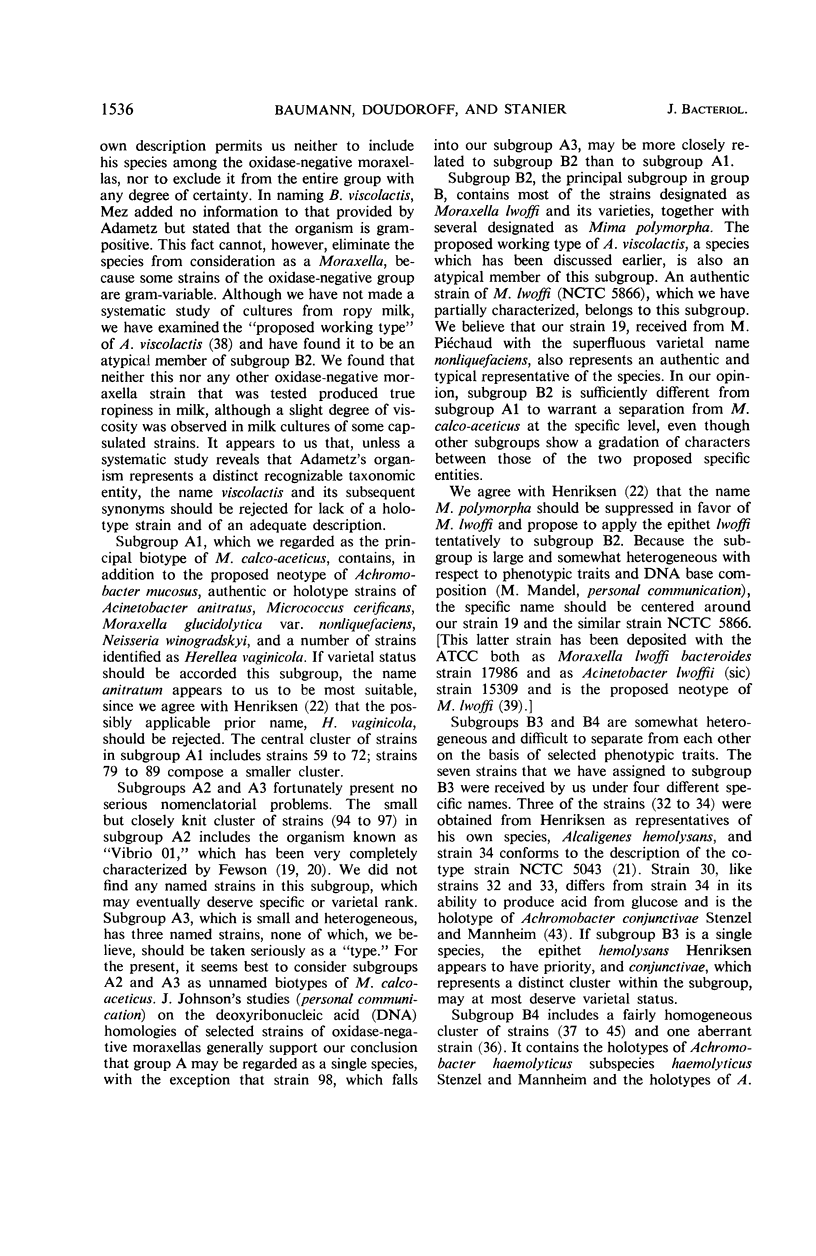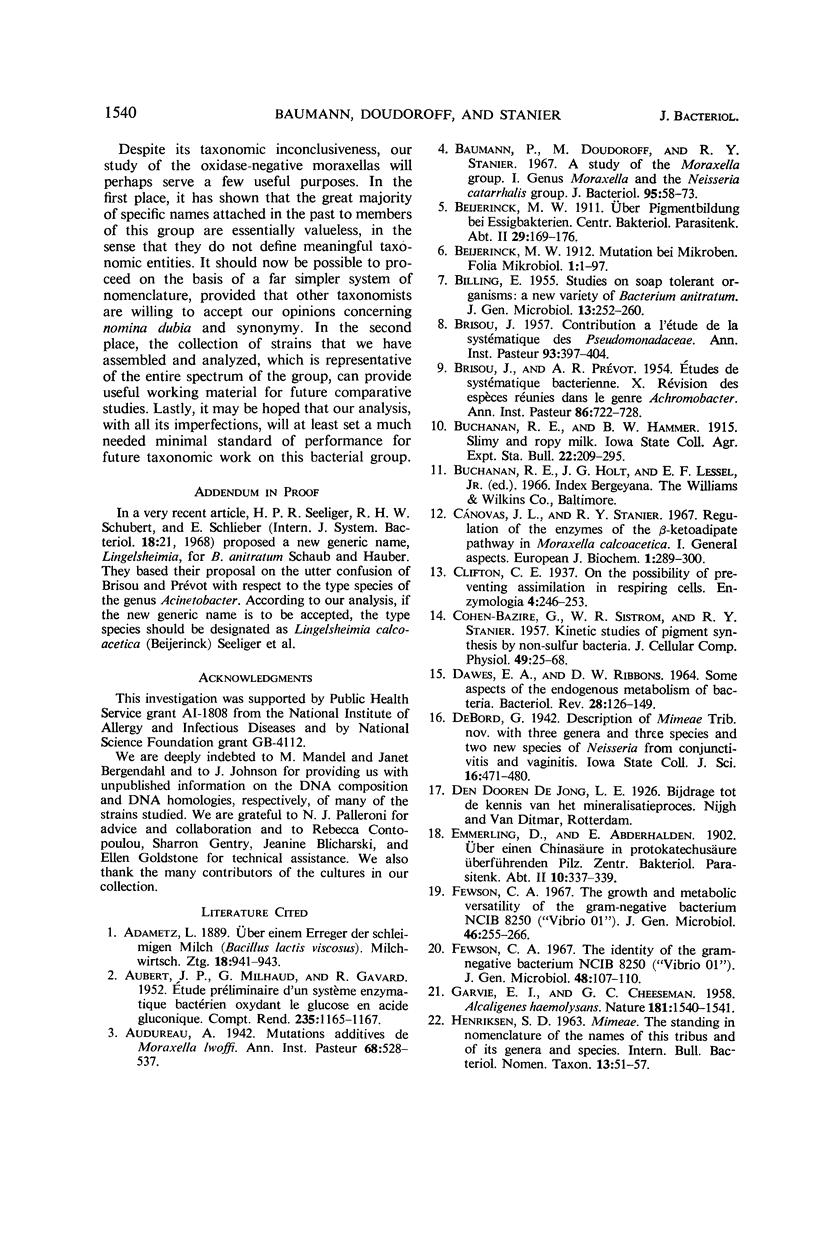Abstract
A number of nutritional and biochemical properties of more than 100 strains of the oxidase-negative moraxellas (the Mima-Herellea-Acinetobacter group of bacteria) were studied. These properties included the range of carbon sources that can support growth, the utilization of nitrate, the production of proteolytic and lipolytic enzymes, and the reactions involved in the oxidation of sugars and of aromatic compounds. No evidence could be obtained for the accumulation of either poly-β-hydroxybutyrate or polysaccharide as intracellular reserve materials. Of 158 different compounds tested, the group as a whole could use 85 as sole carbon sources for growth. The nutritional spectra of the individual strains, however, differed widely, with a range of from 17 to 74 alternative substrates. On the basis of 56 selected nutritional and physiological characters used for a numerical analysis, the collection could be divided into two major groups of strains comprising at least seven less clearly defined clusters. Neither the hydrolysis of gelatin nor acid production from aldose sugars was found to be a reliable index of strain affinities indicated by the phenotypic analysis, although both properties were of some use in distinguishing between the subgroups. For reasons that are discussed, we propose that the oxidase-negative moraxellas be placed in the genus Acinetobacter Brisou and Prévot, for which a modified description is presented. A. calco-aceticus (Beijerinck) is proposed as the type species, of which anitratum is regarded as a synonym or variety. On the basis of the present studies and unpublished supporting evidence provided by M. Mandel on deoxyribonucleic acid (DNA) composition and by J. Johnson on DNA homologies, it is proposed that two other species in the genus, A. lwoffi (Audureau) and A. hemolysans (Henriksen), as well as one subspecies, A. hemolysans haemolyticus (Stenzel and Mannheim), be recognized provisionally.
Full text
PDF





















Images in this article
Selected References
These references are in PubMed. This may not be the complete list of references from this article.
- AUBERT J. P., MILHAUD G., GAVARD R. Etude préliminaire d'un systéme enzymatique bactérien oxydant le glucose en acide gluconique. C R Hebd Seances Acad Sci. 1952 Nov 10;235(19):1165–1167. [PubMed] [Google Scholar]
- BILLING E. Studies on a soap tolerant organism: a new variety of Bacterium anitratum. J Gen Microbiol. 1955 Oct;13(2):252–260. doi: 10.1099/00221287-13-2-252. [DOI] [PubMed] [Google Scholar]
- BRISOU J. Contribution a l'étude de la systématique des Pseudomonadaceae. Ann Inst Pasteur (Paris) 1957 Sep;93(3):397–404. [PubMed] [Google Scholar]
- BRISOU J., PREVOT A. R. Etudes de systématique bactérienne. X. Révision des especes réunies dans le genre Achromobacter. Ann Inst Pasteur (Paris) 1954 Jun;86(6):722–728. [PubMed] [Google Scholar]
- Baumann P., Doudoroff M., Stanier R. Y. Study of the Moraxella group. I. Genus Moraxella and the Neisseria catarrhalis group. J Bacteriol. 1968 Jan;95(1):58–73. doi: 10.1128/jb.95.1.58-73.1968. [DOI] [PMC free article] [PubMed] [Google Scholar]
- COHEN-BAZIRE G., SISTROM W. R., STANIER R. Y. Kinetic studies of pigment synthesis by non-sulfur purple bacteria. J Cell Physiol. 1957 Feb;49(1):25–68. doi: 10.1002/jcp.1030490104. [DOI] [PubMed] [Google Scholar]
- Cánovas J. L., Stanier R. Y. Regulation of the enzymes of the beta-ketoadipate pathway in Moraxella calcoacetica. 1. General aspects. Eur J Biochem. 1967 May;1(3):289–300. doi: 10.1007/978-3-662-25813-2_40. [DOI] [PubMed] [Google Scholar]
- DAWES E. A., RIBBONS D. W. SOME ASPECTS OF THE ENDOGENOUS METABOLISM OF BACTERIA. Bacteriol Rev. 1964 Jun;28:126–149. doi: 10.1128/br.28.2.126-149.1964. [DOI] [PMC free article] [PubMed] [Google Scholar]
- Fewson C. A. The growth and metabolic versatility of the gram-negative Bacterium NCIB 8250 ("Vibrio 01"). J Gen Microbiol. 1967 Feb;46(2):255–266. doi: 10.1099/00221287-46-2-255. [DOI] [PubMed] [Google Scholar]
- GARVIE E. I., CHEESEMAN G. C. Alcaligenes haemolysans. Nature. 1958 May 31;181(4622):1540–1541. doi: 10.1038/1811540a0. [DOI] [PubMed] [Google Scholar]
- HAUGE J. G. Kinetics and specificity of glucose dehydrogenase from Bacterium anitratum. Biochim Biophys Acta. 1960 Dec 4;45:263–269. doi: 10.1016/0006-3002(60)91450-5. [DOI] [PubMed] [Google Scholar]
- Marus A., Bell E. J. Carbohydrate catabolism of Mima polymorpha. II. Abortive catabolism of glucose. J Bacteriol. 1966 Jun;91(6):2229–2236. doi: 10.1128/jb.91.6.2229-2236.1966. [DOI] [PMC free article] [PubMed] [Google Scholar]
- Morris D. L. Quantitative Determination of Carbohydrates With Dreywood's Anthrone Reagent. Science. 1948 Mar 5;107(2775):254–255. doi: 10.1126/science.107.2775.254. [DOI] [PubMed] [Google Scholar]
- PIECHAUD D., PIECHAUD M., SECOND L. Variétes protéolytiques de Moraxella lwoffi et de Moraxella glucidolytica (Bact. anitratum). Ann Inst Pasteur (Paris) 1956 Apr;90(4):517–522. [PubMed] [Google Scholar]
- Pintér M., Bende I. Computer analysis of Acinetobacter iwoffi (Moraxella iwoffii) and Acinetobacter anitratus (Moraxella glucidolytica) strains. J Gen Microbiol. 1967 Feb;46(2):267–272. doi: 10.1099/00221287-46-2-267. [DOI] [PubMed] [Google Scholar]
- Redfearn M. S., Palleroni N. J., Stanier R. Y. A comparative study of Pseudomonas pseudomallei and Bacillus mallei. J Gen Microbiol. 1966 May;43(2):293–313. doi: 10.1099/00221287-43-2-293. [DOI] [PubMed] [Google Scholar]
- SEELIGER H. Zur Systematik des Bacterium anitratum (Schaub und Hauber). Zentralbl Bakteriol Parasitenkd Infektionskr Hyg. 1953 Jan 24;159(3):173–176. [PubMed] [Google Scholar]
- SIERRA G. A simple method for the detection of lipolytic activity of micro-organisms and some observations on the influence of the contact between cells and fatty substrates. Antonie Van Leeuwenhoek. 1957;23(1):15–22. doi: 10.1007/BF02545855. [DOI] [PubMed] [Google Scholar]
- STEEL K. J., COWAN S. T. LE RATTACHEMENT DE BACTERIUM ANITRATUM, MORAXELLA LWOFFI, BACILLUS MALLEI ET HAEMOPHILUS PARAPERTUSSIS AU GENRE ACINETOBACTER BRISOU ET PR'EVOT. Ann Inst Pasteur (Paris) 1964 Mar;106:479–483. [PubMed] [Google Scholar]
- Stanier R. Y., Palleroni N. J., Doudoroff M. The aerobic pseudomonads: a taxonomic study. J Gen Microbiol. 1966 May;43(2):159–271. doi: 10.1099/00221287-43-2-159. [DOI] [PubMed] [Google Scholar]
- VERON M., THIBAULT P., SECOND L. [Neisseria mucosa (Diplococcus mucosus Lingelsheim). I. Bacteriological description and study of its pathogenicity]. Ann Inst Pasteur (Paris) 1959 Oct;97:497–510. [PubMed] [Google Scholar]
- WEIMBERG R., DOUDOROFF M. The oxidation of L-arabinose by Pseudomonas saccharophila. J Biol Chem. 1955 Dec;217(2):607–624. [PubMed] [Google Scholar]
- WEIMBERG R. L-2-Keto-4,5-dihydroxyvaleric acid: an intermediate in the oxidation of L-arabinose by Pseudomonas saccharophila. J Biol Chem. 1959 Apr;234(4):727–732. [PubMed] [Google Scholar]
- WEIMBERG R. Pentose oxidation by Pseudomonas fragi. J Biol Chem. 1961 Mar;236:629–635. [PubMed] [Google Scholar]
- WILLIAMSON D. H., WILKINSON J. F. The isolation and estimation of the poly-beta-hydroxybutyrate inclusions of Bacillus species. J Gen Microbiol. 1958 Aug;19(1):198–209. doi: 10.1099/00221287-19-1-198. [DOI] [PubMed] [Google Scholar]



